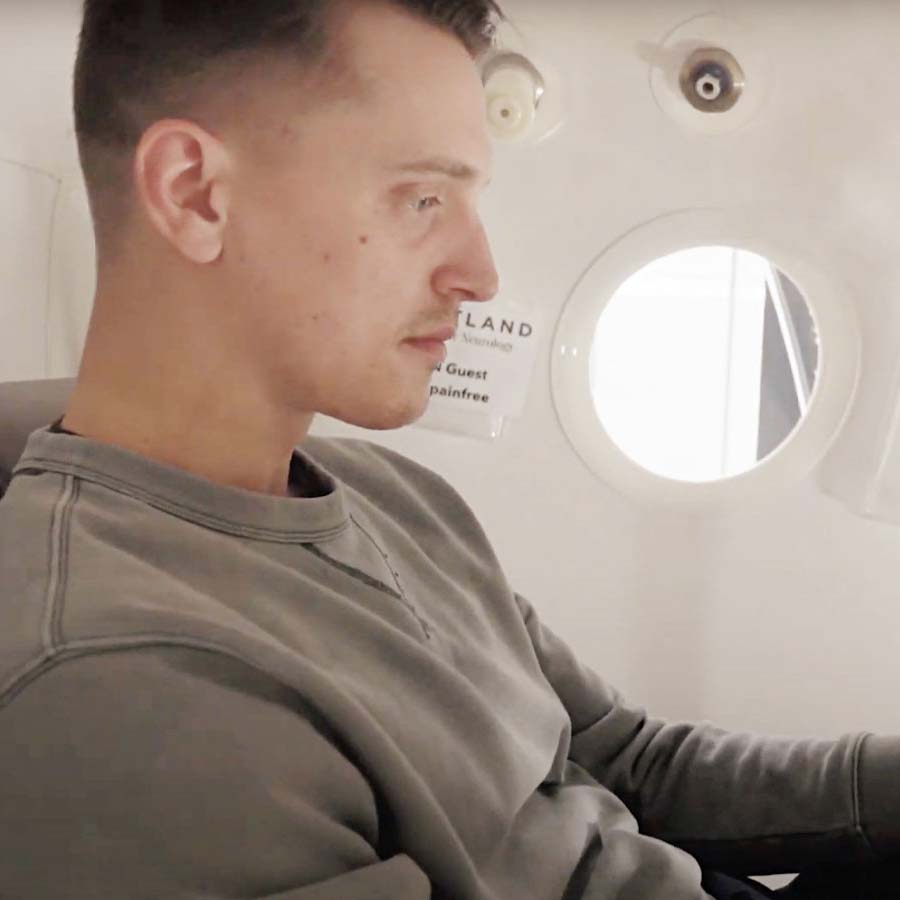
Treating Concussions & Brain Injury with Hyperbaric Oxygen Therapy
Hyperbaric Oxygen Therapy (HBOT) enhances oxygen delivery to the brain by dissolving oxygen directly into the bloodstream, allowing for much higher concentrations than are possible under normal conditions. Due to higher pressure and elevated concentrations of oxygen, it’s able to penetrate deeper into the brain providing the energy needed for neurological growth, repair, and development. In addition, it stimulates the release of growth hormones in the brain that induce neuroplasticity (production of new synapses/connections between brain cells), releases stem cells, dramatically decreases inflammation, decreases fight or flight activity (stress), improves circulation, detoxifies, and stimulates new blood vessel growth in the brain that are all the essential functions that are required for the repair and regeneration of injured tissue as a result of concussions or more serious brain injuries.
Traumatic brain injury (TBI) is the leading cause of death and disability in the US. Approximately 70-90% of the TBI cases are classified as mild, and up to 25% of them will not recover and suffer chronic neurocognitive impairments. The main pathology in these cases involves diffuse brain injuries, which are hard to detect by anatomical imaging such as traditional MRI, CT scans and other medical tests, yet very often noticeable in metabolic imaging such as SPECT, PET scans, functional MRI, eye movement, balance, and vestibular testing as seen in some functional neurology clinics.
Concussions are a type of mild traumatic brain injury. Concussions occur when an impact to the head or body results in abnormal forces within our skull, causing brain injury. Inflammation and blood vessel damage that occurs after a concussion causes hypoxia (low oxygen) in the brain. leading to further damage. Brain cells rely on activation (nerve stimulation) and oxygen to stay healthy, and when they don’t receive adequate amounts of either they weaken, eventually negatively impacting their neurological neighbors, spreading like ripples that occur when throwing a rock into a calm pond.
Research shows that even years after injury, hyperbaric oxygen therapy (HBOT) can induce neuroplasticity leading to repair of chronically impaired brain function and improved quality of life in mild traumatic brain injury patients with prolonged Post Concussion Syndrome (PCS).
Common symptoms
Concussion and Brain Injury can cause a wide range of symptoms, but common symptoms include:
- Light Sensitivity
- Sound Sensitivity
- Brain Fog
- Vertigo (i.e spinning sensation when rolling over, moving your head, or during eye movement)
- Dizziness
- Lightheaded
- Nausea
- Dizziness and Lightheaded Upon Standing or Bending
- Focus and Concentration Issues
- Abnormal Eye Movements or Activity
- Mental Fatigue (may progress to physical fatigue)
- Unequal Pupil Sizes
- Slow Mental Processing
- Reading and Computer Difficulties
- Driving Difficulties
- Behavioral and Emotional Changes (i.e. frustration, anger, impatience)
- Changes in Sleep Patterns
How can hyperbaric oxygen therapy help with Concussion and Brain Injury?
Hyperbaric oxygen therapy may be helpful due to its ability to improve brain tissue function by:
- providing abundant levels of plasma-rich oxygen to our brain tissue for healing
- reducing neuro-inflammation throughout our brain and body
- stimulating release of growth factors such as trophic factor to enhance neuroplasticity for the repair and regeneration of brain cells and their connections (synapses)
- stimulating growth of new blood vessels to supply the brain with greater circulation and oxygen to promote brain repair and regeneration by releasing greater amounts of vascular endothelial growth factor
- balancing our fight or flight and relaxation and digestion systems by strengthening the health of our autonomic nervous system, which is a commonly involved in concussion and brain injury related disorders, impacting blood flow within our brain that leads to dizziness, headaches, slow processing, memory changes and many other symptoms
- increasing stem cell production for healing
- improving detoxification
- enhancing cerebrospinal fluid flow
Treatments such as Hyperbaric Oxygen Therapy can reverse hypoxia and lower acute and chronic inflammation not only healing our brain after concussion, but potentially preventing long-term symptoms associated with post-concussion syndrome. Hyperbaric oxygen therapy repairs our brain by increasing oxygen, blood flow, healing and growing new blood vessels, reducing inflammation, balancing autonomic nervous system function, releasing progenitor and stem cells, and stimulating growth hormones that induce neuroplasticity, resulting in substantial healing, even years after injury.
Other benefits of hyperbaric oxygen therapy
Hyperbaric Oxygen Therapy is a quickly evolving science and the full benefits are continually being discovered. HBOT increases the amount of oxygen in our bloodstream and increases circulation to deliver abundant amounts of oxygen to the brain, supersaturating our tissue with energy needed for healing, growth, and repair. This creates a healthier environment for our brain to work and control our autonomic nervous system. Because of this, the benefits of hyperbaric oxygen therapy can be found in all parts of the body and in a wide range of ways. Some benefits can include:
- Faster healing from trauma
- Reduced inflammation
- Increased stem cell release
- Improved brain health
- Detoxification
- Improved autonomic nervous system function
- …and many more
Learn more about the many benefits of HBOT and how it works.
Supporting Research
- Clinically, HBOT induced significant improvement in the memory, executive functions, information processing speed and global cognitive scores (Hadanny et al).
- The mechanisms by which HBOT induces brain neuroplasticity can be demonstrated by highly sensitive MRI techniques of DSC and DTI. HBOT can induce cerebral angiogenesis and improve both white and gray microstructures indicating regeneration of nerve fibers. The micro structural changes correlate with the neurocognitive improvements (Hadanny et al.)
- HBOT can induce neuroplasticity leading to repair of chronically impaired brain functions and improved quality of life in mTBI patients with prolonged PCS at late chronic stage (Gross et al.)
- The results indicate that HBOT can lead to significant neurological improvements
- Phase II study of two composite doses of hyperbaric therapy that demonstrated significant improvements in PCS and PTSD symptoms at the 2.4 atmospheres absolute (ATA) pure oxygen dose as well as the low-pressure 1.3 ATA air/oxygen dose (Harsch).
- To demonstrate that B-level evidence exists for the use of hyperbaric oxygen therapy (HBOT) as an effective treatment in mild to moderate traumatic brain injury/persistent postconcussion syndrome (mTBI/PPCS).
- Hyperbaric oxygen and hyperbaric air have demonstrated therapeutic effects on mTBI/PPCS symptoms and can alleviate posttraumatic stress disorder symptoms secondary to a brain injury in 5 out of 5 peer-reviewed clinical trials (Figueroa et al.).
- The current use of pressurized air (1.2-1.3 ATA) as a placebo or sham in clinical trials biases the results due to biological activity that favors healing (Figueroa et al.).
- In a review of available treatments for acquired brain injury (ABI), including TBI, HBOT was suggested with strong levels of evidence among non-pharmacological interventions of ABI. Furthermore, HBOT positively improved mortality with level 1 evidence (Meyer et al).
- HBOT remains one of the safest therapies used today (Heyboer et al.)
Sources
- Tal S, Hadanny A, Sasson E, Suzin G, Efrati S. Hyperbaric Oxygen Therapy Can Induce Angiogenesis and Regeneration of Nerve Fibers in Traumatic Brain Injury Patients. Front Hum Neurosci. 2017 Oct 19;11:508. doi: 10.3389/fnhum.2017.00508. PMID: 29097988; PMCID: PMC5654341.
- Boussi-Gross R, Golan H, Fishlev G, Bechor Y, Volkov O, Bergan J, et al. Hyperbaric oxygen therapy can improve post concussion syndrome years after mild traumatic brain injury – randomized prospective trial. PLoS One. 2013; 8(11): e79995.
- Efrati S, Fishlev G, Bechor Y, Volkov O, Bergan J, Kliakhandler K, et al. Hyperbaric oxygen induces late neu- roplasticity in post stroke patients–randomized, prospective trial. PLoS One. 2013; 8(1): e53716.
- Harch PG. Hyperbaric oxygen therapy for post-concussion syndrome: contradictory conclusions from a study mischaracterized as sham-controlled. J Neurotrauma. 2013 Dec 1;30(23):1995-9. doi: 10.1089/neu.2012.2799. Epub 2013 Oct 11. PMID: 24004322; PMCID: PMC3837504.
- Kendall et al. Different oxygen treatment pressures alter inflammatory gene expression in human endothelial cells. March 2013. Undersea & hyperbaric medicine: journal of the Undersea and Hyperbaric Medical Society, Inc 40(2):115-23
- Huang L, Obenaus A. Hyperbaric oxygen therapy for traumatic brain injury. Med Gas Res. 2011 Sep 6;1(1):21. doi: 10.1186/2045-9912-1-21. PMID: 22146562; PMCID: PMC3231802.
- Figueroa XA, Wright JK. Hyperbaric oxygen: B-level evidence in mild traumatic brain injury clinical trials. Neurology. 2016 Sep 27;87(13):1400-6. doi: 10.1212/WNL.0000000000003146. Epub 2016 Aug 31. PMID: 27581219.
- Huang L, Obenaus A. Hyperbaric oxygen therapy for traumatic brain injury. Med Gas Res. 2011; 1(1): 21.
- Neubauer RA, James P. Cerebral oxygenation and the recoverable brain. Neurol Res. 1998; 20 Suppl 1: S33-6.
- Vlodavsky E, Palzur E, Soustiel JF. Hyperbaric oxygen therapy reduces neuroinflammation and expression of matrix metalloproteinase-9 in the rat model of traumatic brain injury. Neuropathol Appl Neurobiol. 2006; 32(1): 40-50.
- Lin KC, Niu KC, Tsai KJ, Kuo JR, Wang LC, Chio CC, et al. Attenuating inflammation but stimulating both angio- genesis and neurogenesis using hyperbaric oxygen in rats with traumatic brain injury. J Trauma Acute Care Surg. 2012; 72(3): 650-9.
- Zhou Z, Daugherty WP, Sun D, Levasseur JE, Altememi N, Hamm RJ, Rockswold GL, Bullock MR. Protection of mitochondrial function and improvement in cognitive recovery in rats treated with hyperbaric oxygen following lateral fluid-percussion injury. J Neurosurg. 2007 Apr;106(4):687-94. doi:
- Heyboer M 3rd, Sharma D, Santiago W, McCulloch N. Hyperbaric Oxygen Therapy: Side Effects Defined and Quantified. Adv Wound Care (New Rochelle). 2017 Jun 1;6(6):210-224. doi: 10.1089/wound.2016.0718. PMID: 28616361; PMCID: PMC5467109.
- Heyboer M 3rd, Sharma D, Santiago W, McCulloch N. Hyperbaric Oxygen Therapy: Side Effects Defined and Quantified. Adv Wound Care (New Rochelle). 2017 Jun 1;6(6):210-224. doi: 10.1089/wound.2016.0718. PMID: 28616361; PMCID: PMC5467109.
Contact Us
Ready to discuss how hyperbaric oxygen therapy can help you heal, rebuild and restore health?
Contact Us